Flink standalone模式作业执行流程
宏观流程如下图:
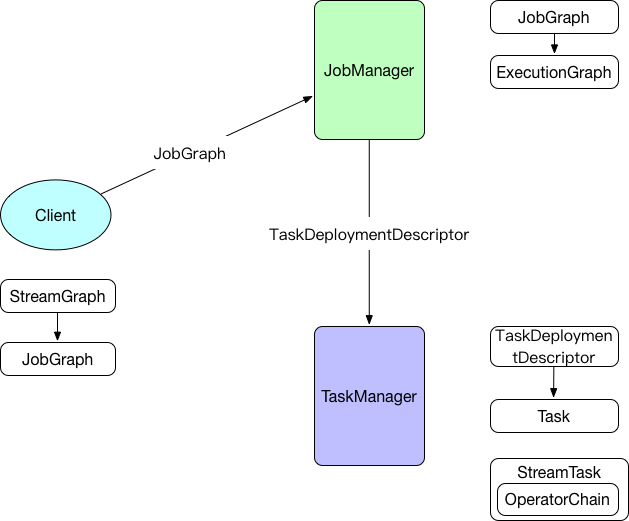
client端
生成StreamGraph
env.addSource(new SocketTextStreamFunction(...))
.flatMap(new FlatMapFunction())
.keyBy("word")
.timeWindow(Time.seconds(5))
.reduce(new ReduceFunction())
.print()
StreamExecutionEnvironment上的一系列api调用会在env->transformations中添加相应的StreamTransformation对象,然后调用StreamGraphGenerator->transformation方法遍历所有的StreamTransformation对象生成最终的StreamGraph。
如上代码段会生成如下StreamGraph:
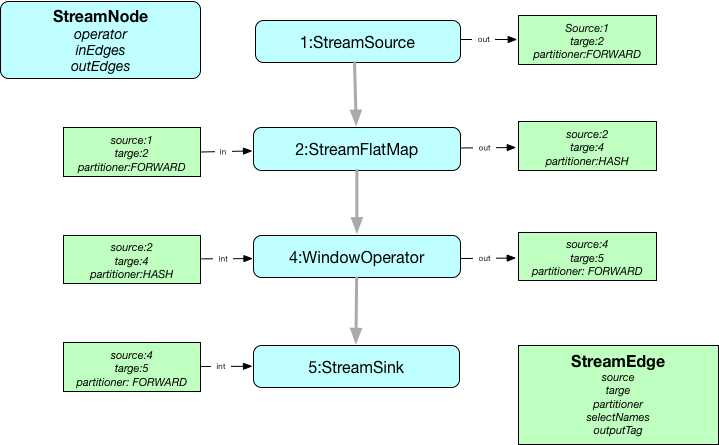
StreamGraph->JobGraph
private List<StreamEdge> createChain(
Integer startNodeId,
Integer currentNodeId,
Map<Integer, byte[]> hashes,
List<Map<Integer, byte[]>> legacyHashes,
int chainIndex,
Map<Integer, List<Tuple2<byte[], byte[]>>> chainedOperatorHashes)
从StreamGraph的所有sourceStreamNode开始遍历处理,如果是可链接的(isChainable为true)则继续,同时生成该节点的StreamConfig信息(包含StreamOperator``chainIndex``chainEnd等),否则生成新的JobVertex,最后链接connect函数创建JobEdge对象链接JobVertex。
public static boolean isChainable(StreamEdge edge, StreamGraph streamGraph) {
StreamNode upStreamVertex = edge.getSourceVertex();
StreamNode downStreamVertex = edge.getTargetVertex();
StreamOperator<?> headOperator = upStreamVertex.getOperator();
StreamOperator<?> outOperator = downStreamVertex.getOperator();
return downStreamVertex.getInEdges().size() == 1
&& outOperator != null
&& headOperator != null
&& upStreamVertex.isSameSlotSharingGroup(downStreamVertex)
&& outOperator.getChainingStrategy() == ChainingStrategy.ALWAYS
&& (headOperator.getChainingStrategy() == ChainingStrategy.HEAD ||
headOperator.getChainingStrategy() == ChainingStrategy.ALWAYS)
&& (edge.getPartitioner() instanceof ForwardPartitioner)
&& upStreamVertex.getParallelism() == downStreamVertex.getParallelism()
&& streamGraph.isChainingEnabled();
}
如上代码会生成包含两个JobVertex对象的JobGraph:
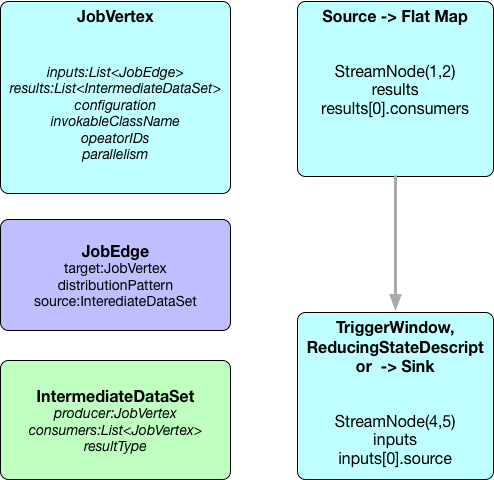
JobVertex的configuration属性中的chainedTaskConfig_``chainedOutputs分别包含了该节点链接的所有StreamNode节点的配置信息和所有SteamNode本身序列化后的二进制数组
JobManager
主要把客户端提交的JobGraph转化成ExecutionGraph,并把ExecutionGraph包含的所有ExecutionVertex对应的Execution提交给分配到其执行所需资源的TaskManager
DistributionPattern分发模式用于确定生产者(产生中间结果IntermediateResultPartition)与其消费者(通过ExecutionEdge)怎样链接
switch (channel.getShipStrategy()) {
case FORWARD:
distributionPattern = DistributionPattern.POINTWISE;
break;
case PARTITION_RANDOM:
case BROADCAST:
case PARTITION_HASH:
case PARTITION_CUSTOM:
case PARTITION_RANGE:
case PARTITION_FORCED_REBALANCE:
distributionPattern = DistributionPattern.ALL_TO_ALL;
break;
default:
throw new RuntimeException("Unknown runtime ship strategy: " + channel.getShipStrategy());
}
ExecutionVertex之间如何链接:
ALL_TO_ALL模式:
则每一个并行的ExecutionVertex节点都会链接到源节点产生的所有中间结果IntermediateResultPartition

POINTWISE模式:源的并行度和目标并行度相等。这种情况下,采用一对一的链接方式:

源的并行度小于目标并行度。这种情况下,对于每一个执行节点链接到的源的中间结果分区由如下公式计算得到:
sourcePartition = (int)subTaskIndex / (((float) parallelism) / numSources)
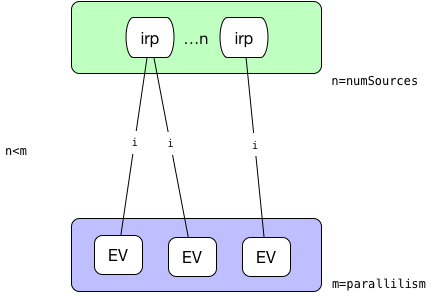 * 源的并行度大于目标并行度。这种情况下,计算每一个执行节点会平均链接到几个源节点,平均分配后余下的都分给最后一个节点。
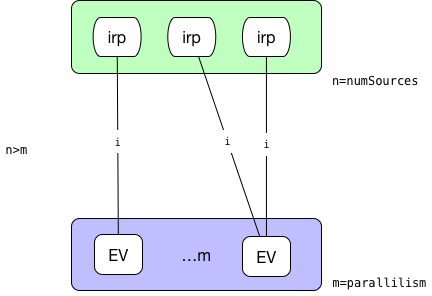
最后提交给TaskManager的TaskDeploymentDescriptor如下:
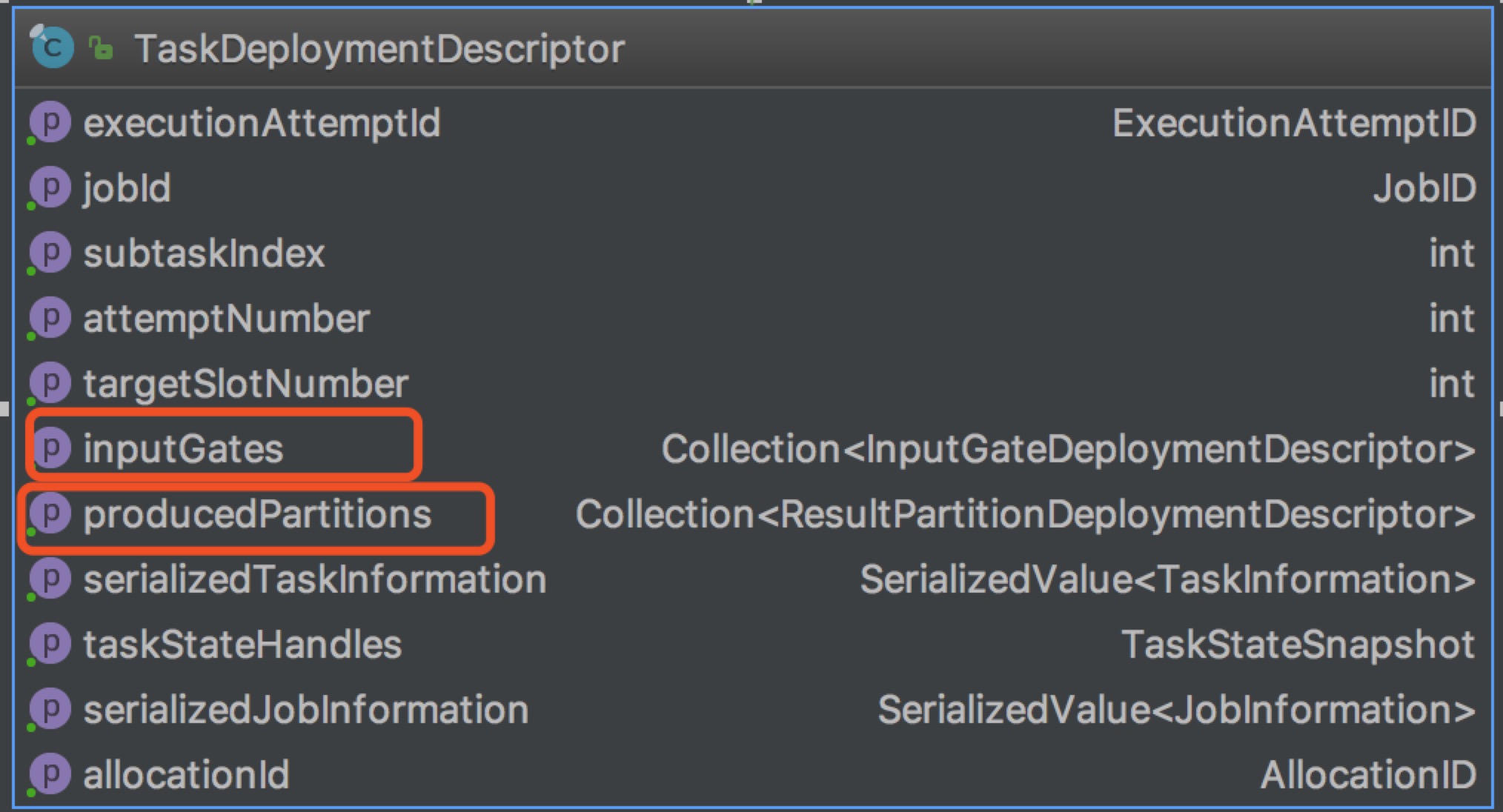
ResultPartitionDeploymentDescriptor有一个numberOfSubpartitions字段,其等于此ResultPartition的消费者的数量(被下级链接到的边数),因为最终执行的时候每一个ResultPartition还会拆分为numberOfSubpartitions相同数量的ResultSubPartition。
InputGateDeploymentDescriptor包含多个InputChannelDeploymentDescriptor和一个用以指示消费第几个ResultSubPartition的consumedSubpartitionIndex。每一个InputGateDeploymentDescriptor消费的所有ResultPartition的subPartitionIndex是一样的。

例如并行度均为2的两个ExecutionJobVertex采用ALL_TO_ALL方式链接的结果如下:
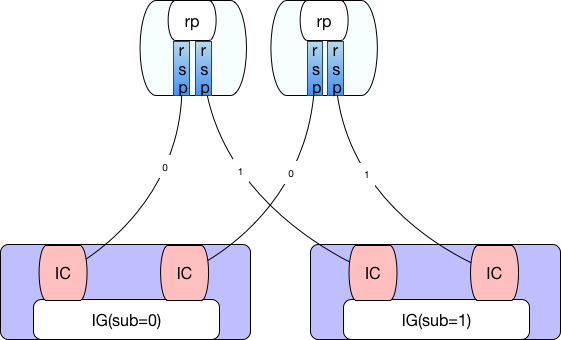
TaskManager
TaskManager接收到TaskDeploymentDescriptor对象后进行反序列化生成Task对象并进行一系列的初始化操作(如:根据ResultPartitionDeploymentDescriptor对象初始化writers[ResultPartitionWriter],根据InputGateDeploymentDescriptor初始化inputGates[SingleInputGate],重新设置classLoader等)然后启用新线程执行invokable[AbstractInvokable]->invoke方法。
也就是说Task的主要业务逻辑其实都包含在了AbstractInvokable对象中,我们来具体看下其子类StreamTask(SourceStreamTask和OneInputStreamTask)
StreamTask的invoke方法会创建OperatorChain
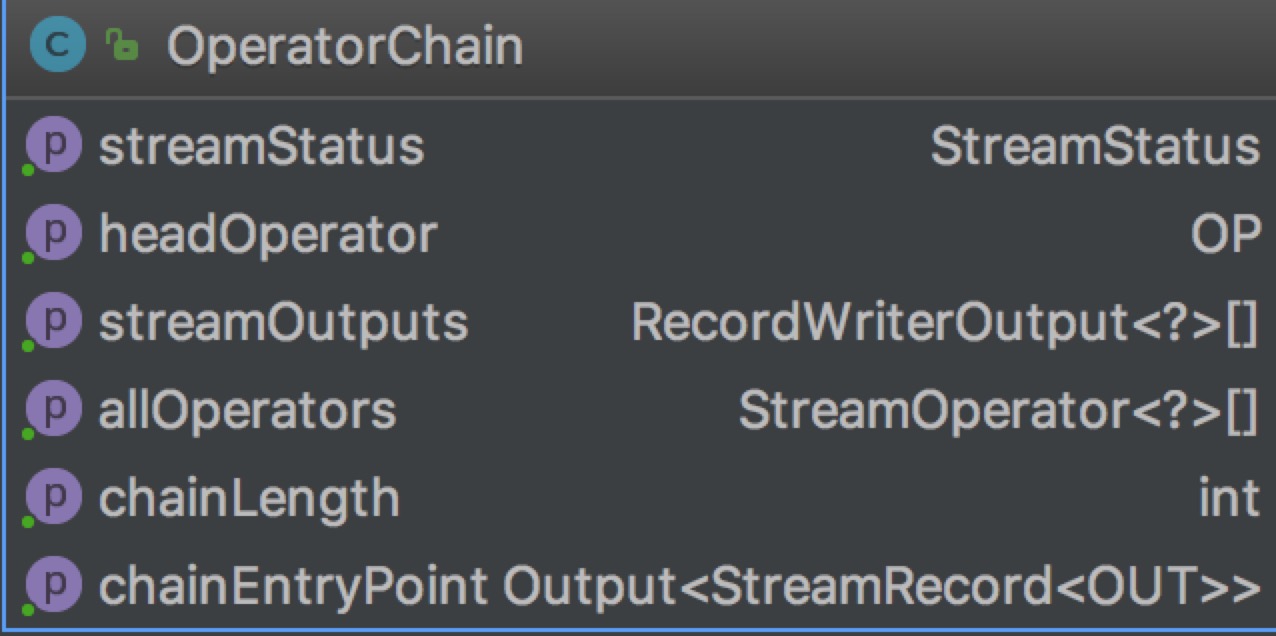
重点关注chainEntryPoint这个属性是BroadcastingOutputCollector类型,其collect方法如下:
public void collect(StreamRecord<T> record) {
for (Output<StreamRecord<T>> output : outputs) {
output.collect(record);
}
}
即使依次遍历链中的每一个output进行collect操作,而其中的每一个output又是ChainingOutput及其子类。
@Override
public void collect(StreamRecord<T> record) {
if (this.outputTag != null) {
// we are only responsible for emitting to the main input
return;
}
pushToOperator(record);
}
protected <X> void pushToOperator(StreamRecord<X> record) {
try {
// we know that the given outputTag matches our OutputTag so the record
// must be of the type that our operator expects.
@SuppressWarnings("unchecked")
StreamRecord<T> castRecord = (StreamRecord<T>) record;
numRecordsIn.inc();
operator.setKeyContextElement1(castRecord);
operator.processElement(castRecord);
}
catch (Exception e) {
throw new ExceptionInChainedOperatorException(e);
}
}
其中operator是OneInputStreamOperator类型其子类业务实现逻辑(processElement)方法:调用用户自定义函数userFunction[Function]处理后按需调用output.collect(element)其中output可能也是一个ChainingOutput类型,这样整个执行链路就被一级一级链接起来了。
this.chainEntryPoint = createOutputCollector(
containingTask,
configuration,
chainedConfigs,
userCodeClassloader,
streamOutputMap,
allOps);
if (headOperator != null) {
Output output = getChainEntryPoint();
headOperator.setup(containingTask, configuration, output);
}
对于StreamTask常见的一个子类SourceStreamTask,其run方法:
@Override
protected void run() throws Exception {
headOperator.run(getCheckpointLock(), getStreamStatusMaintainer());
}
对于OperatorChain链上最后一个operator其output为RecordWriterOutput类型其封装了StreamRecordWriter配合ChannelSelector写入到具体的某个ResultSubPartition
public void emit(T record) throws IOException, InterruptedException {
for (int targetChannel : channelSelector.selectChannels(record, numChannels)) {
sendToTarget(record, targetChannel);
}
}
常见的ChannelSelector:
RescalePartitioner|RebalancePartitioner: 轮询KeyGroupStreamPartitioner: 基于key分组GlobalPartitioner: 全局,只通过subpartition==0ShufflePartitioner:随机到子分区ForwardPartitioner: 本地转发BroadcastPartitioner: 广播到所有分区
另一个StreamTask常见的一个子类OneInputStreamTask,其run方法:
@Override
protected void run() throws Exception {
// cache processor reference on the stack, to make the code more JIT friendly
final StreamInputProcessor<IN> inputProcessor = this.inputProcessor;
while (running && inputProcessor.processInput()) {
// all the work happens in the "processInput" method
}
}
其inputProcessor是StreamInputProcessor类型,在init方法中创建
if (checkpointMode == CheckpointingMode.EXACTLY_ONCE) {
long maxAlign = taskManagerConfig.getLong(TaskManagerOptions.TASK_CHECKPOINT_ALIGNMENT_BYTES_LIMIT);
if (!(maxAlign == -1 || maxAlign > 0)) {
throw new IllegalConfigurationException(
TaskManagerOptions.TASK_CHECKPOINT_ALIGNMENT_BYTES_LIMIT.key()
+ " must be positive or -1 (infinite)");
}
this.barrierHandler = new BarrierBuffer(inputGate, ioManager, maxAlign);
}
else if (checkpointMode == CheckpointingMode.AT_LEAST_ONCE) {
this.barrierHandler = new BarrierTracker(inputGate);
}
barrierHandler与设置的CheckpointingMode相关:
EXACTLY_ONCE:BarrierBufferAT_LEAST_ONCE:BarrierTracker
inputProcessor的processInput方法会调用barrierHandler.getNextNonBlocked()如果获取到一条完整记录则调用streamOperator.processElement(record)触发整体调用链的执行。
Flink standalone模式作业执行流程的更多相关文章
- 追源索骥:透过源码看懂Flink核心框架的执行流程
li,ol.inline>li{display:inline-block;padding-right:5px;padding-left:5px}dl{margin-bottom:20px}dt, ...
- 透过源码看懂Flink核心框架的执行流程
前言 Flink是大数据处理领域最近很火的一个开源的分布式.高性能的流式处理框架,其对数据的处理可以达到毫秒级别.本文以一个来自官网的WordCount例子为引,全面阐述flink的核心架构及执行流程 ...
- Spark架构与作业执行流程简介(scala版)
在讲spark之前,不得不详细介绍一下RDD(Resilient Distributed Dataset),打开RDD的源码,一开始的介绍如此: 字面意思就是弹性分布式数据集,是spark中最基本的数 ...
- Spark架构与作业执行流程简介
https://www.cnblogs.com/shenh062326/p/3658543.html
- Flink架构分析之Standalone模式启动流程
概述 FLIP6 对Flink架构进行了改进,引入了Dispatcher组件集成了所有任务共享的一些组件:SubmittedJobGraphStore,LibraryCacheManager等,为了保 ...
- Map/Reduce 工作机制分析 --- 作业的执行流程
前言 从运行我们的 Map/Reduce 程序,到结果的提交,Hadoop 平台其实做了很多事情. 那么 Hadoop 平台到底做了什么事情,让 Map/Reduce 程序可以如此 "轻易& ...
- 第九篇:Map/Reduce 工作机制分析 - 作业的执行流程
前言 从运行我们的 Map/Reduce 程序,到结果的提交,Hadoop 平台其实做了很多事情. 那么 Hadoop 平台到底做了什么事情,让 Map/Reduce 程序可以如此 "轻易& ...
- 面试高频SpringMVC执行流程最优解(源码分析)
文章已托管到GitHub,大家可以去GitHub查看阅读,欢迎老板们前来Star! 搜索关注微信公众号 码出Offer 领取各种学习资料! SpringMVC执行流程 SpringMVC概述 Spri ...
- Thinkphp设计模式和执行流程
ThinkPHP设计模式 单例模式:数据库连接DB工厂模式:比如Db.class.php中的factory()方法适配器模式:驱动类,数据库观察者模式:Hook类 注册树模式:绑定容器外观模式:fac ...
随机推荐
- python3: 数字日期和时间(2)
12.基本的日期与时间转换 Q: 你需要执行简单的时间转换,比如天到秒,小时到分钟等的转换 A: 为了执行不同时间单位的转换和计算,请使用 datetime 模块. 比如,为了表示一个时间段,可以创建 ...
- 1.Solr介绍
转载请出自出处:http://www.cnblogs.com/hd3013779515/ Solr是一个基于Lucene的全文搜索引擎,同时对其进行了扩展,提供了比Lucene更为丰富的查询语言,实现 ...
- Android与js交互拍照上传资料
应用场景:h5通知android端拍照,选相册,然后将图片路径上传成功之后,获取到网络路径,将此路径返还给h5界面,并展示出来. android与js快速交互 效果图如下: 1.在Activity ...
- php的匿名函数和闭包函数
php的匿名函数和闭包函数 tags: 匿名函数 闭包函数 php闭包函数 php匿名函数 function use 引言:匿名函数和闭包函数都不是特别高深的知识,但是很多刚入门的朋友却总是很困惑,因 ...
- CJOJ 【DP合集】最长上升序列2 — LIS2
题面 已知一个 1 ∼ N 的排列的最长上升子序列长度为 K ,求合法的排列个数. 好题(除了我想不出来我应该找不到缺点), 想一想最长上升子序列的二分做法, 接在序列后面或者替换. 所以对于每一个位 ...
- [转]深入理解MFC中程序框架
最近抽空复习了一下MFC的内容,觉得一篇博文写的不错. 原文内容太多直接给出链接吧:深入理解MFC中程序框架 链接2:深入浅出话VC++(2)——MFC的本质 链接3:MFC单文档/视图结构穷追猛打
- UART串口通信
#include "sys.h" #include "delay.h" #include "usart.h" u8 rdata[]; UAR ...
- 了解linux的进程:rootfs与linuxrc
导读 内核启动的最后阶段启动了三个进程进程0:进程0其实就是刚才讲过的idle进程,叫空闲进程,也就是死循环.进程1:kernel_init函数就是进程1,这个进程被称为init进程.进程2:kthr ...
- leetcode709—To Lower Case
Implement function ToLowerCase() that has a string parameter str, and returns the same string in low ...
- Javascript异步编程之setTimeout与setInterval详解分析(一)
Javascript异步编程之setTimeout与setInterval 在谈到异步编程时,本人最主要会从以下三个方面来总结异步编程(注意:特别解释:是总结,本人也是菜鸟,所以总结不好的,请各位大牛 ...
